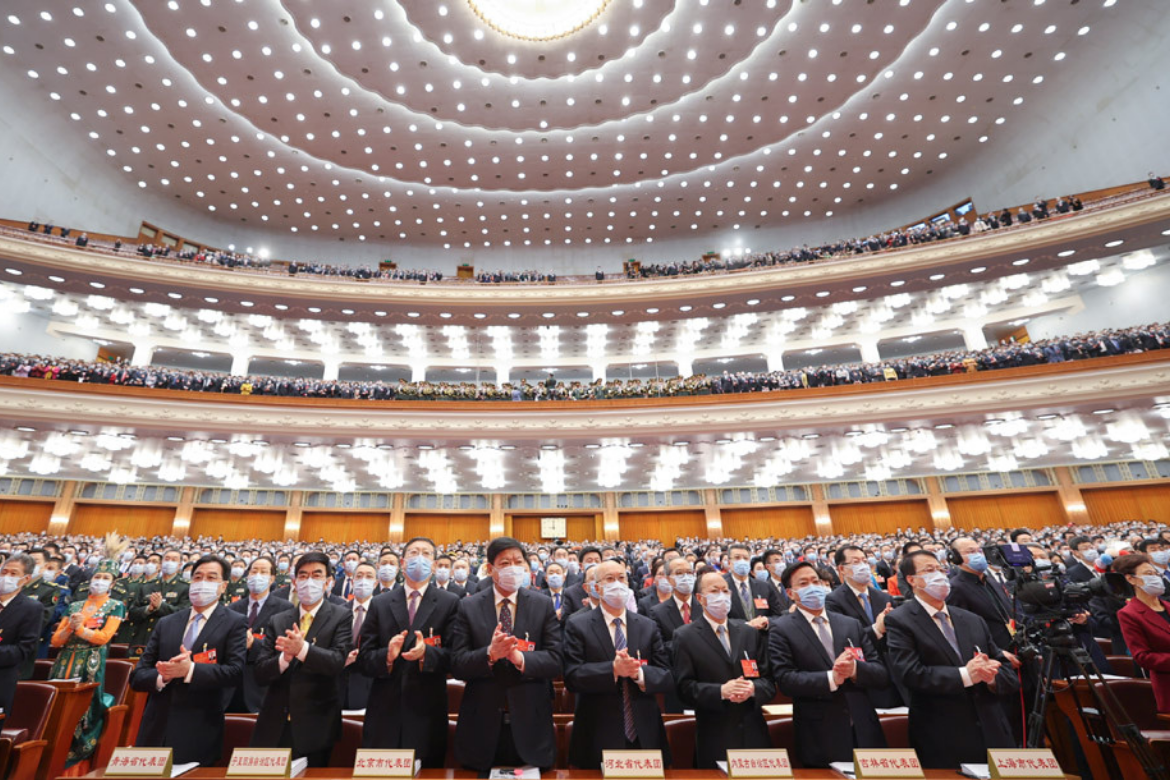- The yearly report acknowledges China’s significant advances in research on core technologies and the country’s breakthroughs in manned spaceflight, Mars exploration, resource exploration and energy projects.
- The report also notes the accelerated integration of digital technology into the economy and underlines that corporate spending on research and development had grown by 15.5%.
- To achieve peak carbon emissions by 2030 and carbon neutrality by 2060, China plans to intensify its efforts to cultivate green and low-carbon working and living models and increase the carbon absorption capacity of its ecosystems.
China’s two main political bodies – its top legislature, the National People’s Congress (NPC), and its top political advisory body, the Chinese People’s Political Consultative Conference (CPPCC) – recently gathered in Beijing to vote on the country’s key policies for the coming year during a set of annual meetings, known as the “Two Sessions.” Generally recognised as one of China’s most important yearly political events, the sessions were of additional significance, as they not only followed the 100th anniversary of the Communist Party of China (CCP), which was celebrated in July 2021 but also preceded the 20th Party Congress, during which President Xi Jinping will likely be confirmed for a third term as party leader.
In this context, here is an overview of a selection of pertinent points mentioned in the “Government Work Report” (henceforth, the “report”). It was delivered for the final time by Premier Li Keqiang in his capacity as Premier, and not only offers a useful overview of China’s main economic and social achievements of the past year, but also outlines the country’s priorities for the coming year. This outline sets the trend for the upcoming opportunities in China.
A Review of 2021
Beginning with the main achievements, Premier Li Keqiang revealed that China’s gross domestic product (GDP) reached RMB 114 trillion in 2021 – i.e. an increase of 8.1% compared to last year. This came as a surprise to many observers, given the continued prevalence of COVID-19 worldwide. It was, in turn, complemented by the creation of an additional 12.69 million urban jobs, an increase in the consumer price index (CPI) of 0.9% and the development of more resilient industrial chains. In addition, rapid growth was recorded in the high-tech manufacturing sector (+18.2%) and IT services and other producer services.
In the domain of science, technology, and innovation, the report acknowledged China’s significant advances in research on core technologies. It emphasised the country’s breakthroughs in manned spaceflight, Mars exploration, resource exploration and energy projects. The report noted the accelerated integration of digital technology into the economy and underlined that corporate spending on research and development had grown by 15.5%.
The report discussed China’s efforts to actively respond to climate change actively and improve the quality of the environment by taking additional steps to curtail pollution and by establishing the country’s first group of national parks. China also unveiled an action plan to peak carbon emissions by 2030, launched the so-called “China Carbon Emission Trade Exchange,” and now disposes of an installed capacity of renewable power that exceeds one billion kilowatts.
However, despite recognising China’s achievements in the past year, the general assessment of the report was a bit subdued, as Premier Li Keqiang also pointed to a number of “problems and challenges” – both at home and abroad – that await the country in the coming year. These, among others, include the “triple pressures of shrinking demand, disrupted supply and weakening expectations,” a sluggish recovery in consumption and investment, a lack of capacity to support innovation in certain key areas, as well as sporadic local COVID-19 outbreaks, which continue to test China’s zero-COVID policy.
Economic Stability, Employment & Education
Against this backdrop, ensuring economic stability – i.e. maintaining stable employment, meeting basic living needs, and guarding against risks – was unsurprisingly emphasised as a top priority throughout the “Two Sessions.” However, the report also set forth 11 development targets for 2022, which, among others, included:
- Achieving a GDP growth of around 5.5%;
- Creating over 11 million new urban jobs;
- Achieving a CPI growth of about 3%;
- Increasing the volume and quality of imports and exports;
- Achieving a basic equilibrium in the balance of payments;
- Achieving a grain output of over 650 million metric tons; and
- Improving the environment and reducing major pollutants.
To achieve this, the plan, in particular, announced the introduction of a new package of tax-and-fee policies to support businesses, which consisted of:
- Extending and expanding the scale and scope of tax and fee reduction policies that support manufacturing, self-employed individuals, and micro and small enterprises.
- Prioritising large-scale value-added tax (VAT) and credit refunds for micro and small enterprises, manufacturing, research and technical services, environmental protection, electricity and gas, and transportation industries.
Under this plan, tax refunds and cuts are expected to amount to approximately RMB 2.5 trillion in 2022 – RMB 1.5 trillion of which are projected to come from VAT credit refunds. This, in turn, will be coupled with additional support for inclusive loans to micro and small businesses and measures to stabilise employment and assist the country’s next 10 million college graduates in finding a job or starting their own business.
High-Quality Domestic Innovation
Pursuant to Xi Jinping’s report at the 19th CPC National Congress, during which he note that “China’s economy has been transitioning from a phase of rapid growth to a stage of high-quality development,” the importance of promoting China’s domestic innovation was also heavily emphasized in this year’s Government Work Report.
The importance of promoting China’s domestic innovation – viewed as the “primary driving force behind development” and the “strategic underpinning for building a modernised economy” (ibid) – was also heavily emphasised. This was especially true for China’s “strategic sectors,” which, according to the plan, include semiconductors, AI, and 5G, and several “emerging industries,” such as biotechnology, new materials, aviation and aerospace and new energy.
To achieve this, the plan contends that China will continue to accelerate its capacity for scientific and technological innovation by increasing its long-term support for basic research, reforming its science and technology management system, and further leveraging and expanding on the strengths of its higher education and research institutions. In this context, the plan, in particular, emphasises the importance of strengthening China’s institutions and mechanisms for developing and supporting young talent and its continued engagement and cooperation with the international scientific and technological community.
In addition, the plan foresaw the provision of stronger incentives to promote innovation among enterprises, such as by ensuring stronger protection of intellectual property rights and encouraging businesses to invest more in R&D with the introduction of favourable tax policies and the development of new financial products and services.
Self-Reliance, Stability and Climate Change
Despite this strong emphasis on boosting China’s high-tech innovation capacity, the plan alluded to a number of challenges that needed to be addressed. It also mentioned the importance of promoting stability and domestic self-reliance within a relatively uncertain global environment.
In this context, two key priorities were China’s goal of increasing personal incomes and spending power to boost consumption, , as well as its continued efforts to ensure a secure food supply for the more than 1.4 billion people who live in its territory. Regarding the latter, the plan, for example, highlighted a number of measures to ensure that China possesses a minimum of 120 million hectares of farmland at all times. It also advocated for a “redoubling of efforts to develop and apply scientific and technological breakthroughs in agriculture” and upgrading its agricultural machinery and equipment.
Parallel to these two priorities, the plan accentuated the need to safeguard the stability and security of industrial and supply chains to maintain the core competitiveness of China’s manufacturing sector and ultimately elevate it toward the medium and high-end.
Finally, despite the plan’s emphasis on stability, it also reaffirmed China’s commitment to achieving peak carbon emissions by 2030 and carbon neutrality by 2060. To achieve this, China will put its action plan for peaking carbon emissions into effect, intensify its efforts to cultivate green and low-carbon working and living models, and increase the carbon absorption capacity of its ecosystems. In addition, the plan asserted that China would maintain its efforts to expand the share of electricity generated from renewable energy sources – mainly via the construction of additional large-scale wind and photovoltaic power bases, as well as pumped-storage hydroelectric plants – and improve the capacity of its grid to support and absorb these volatile sources of energy effectively.
Conclusion and Outlook
Despite China’s focus on promoting economic stability and self-sufficiency at home, one key externality could potentially continue to challenge these aspirations in 2022: COVID-19. Although China has been remarkably successful at containing the pandemic domestically, this has come at the cost of having to maintain a strict set of non-pharmaceutical interventions as part of the country’s “zero COVID” policy at a time when many other countries have moved towards a loosening of their respective measures. Even so, China has still had to contend with sporadic outbreaks and recently implemented one of the country’s most extensive lockdowns in two years to control a growing outbreak in Shanghai, thereby highlighting the continued challenge that the SARS-CoV-2 variants of interest (VOI) and concern (VOC) are posing to Chinese lawmakers.
(This article only provided a brief overview of a few topics addressed in the report and the two sessions. Please consult the original report for a comprehensive overview which can be accessed here).
References
Brunswick Group. China’s 2022 Two Sessions: Ensuring Stability Amid Global Uncertainty [online]. 13.03.2022. Available at: https://www.brunswickgroup.com/two-sessions-2022-i20895/
HULD, Arendse and ZHOU, Qian. China’s 2022 Government Work Report: Highlights from the Two Sessions [online]. 07.03.2022. Available at: https://www.china-briefing.com/news/chinas-2022-government-work-report-highlights-from-the-two-sessions/
LI, Keqiang. Report on the Work of the Government [speech]. 05.03.2022. Delivered at the Fifth Session of the 13th National People’s Congress of the People’s Republic of China. Available at: http://english.www.gov.cn/premier/news/202203/12/content_WS622c96d7c6d09c94e48a68ff.html
MAI, Jun. China’s ‘two sessions’: why this year’s event is so important for Xi Jinping’s vision for the future [online]. 21.02.2021. https://www.scmp.com/news/china/politics/article/3122544/chinas-two-sessions-why-years-event-so-important-xi-jinpings (accessed on 28.03.2022).
XI, Jinping. Secure a Decisive Victory in Building a Moderately Prosperous Society in All Respects and Strive for the Great Success of Socialism with Chinese Characteristics for a New Era [speech]. 18.10.2017. Delivered at the 19th National Congress of the Communist Party of China. Available at: https://www.mfa.gov.cn/ce/ceil/eng/zt/19thCPCNationalCongress/t1512045.htm






NO COMMENT